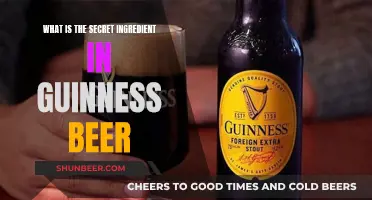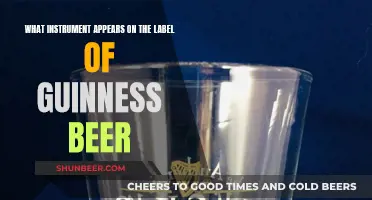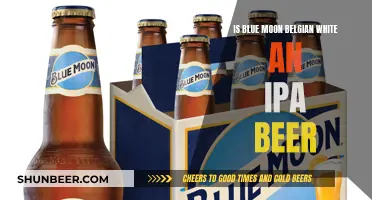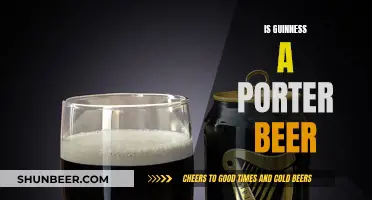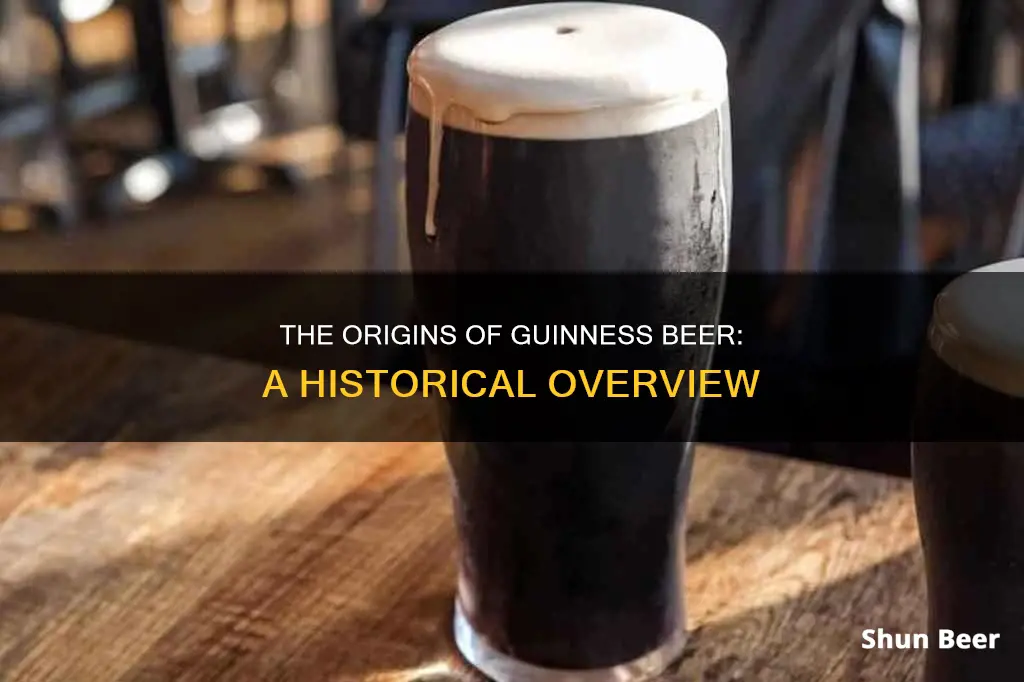
Guinness is a stout beer that originated in Dublin, Ireland, in the 18th century. It was first brewed by Arthur Guinness, who signed a 9,000-year lease for the St. James's Gate Brewery in 1759. Initially, Guinness brewed a variety of ales and beers, but in 1799, the company decided to focus exclusively on porter, a dark beer with a rich head. Guinness died in 1803, but his descendants continued to run the business for generations, and it became known as the national beer of Ireland.
| Characteristics | Values |
|---|---|
| Brand | Guinness |
| Type of Beer | Stout |
| Company | Diageo |
| Founded | 1759 |
| Founder | Arthur Guinness |
| Location | St. James's Gate Brewery, Dublin, Ireland |
| Lease Duration | 9,000 years |
| Ingredients | Water, barley, hops, yeast |
| Flavour | Malted barley, roasted unmalted barley |
What You'll Learn

The history of Guinness
Arthur Guinness died in 1803, and his son, Arthur Guinness II, took over the family business. Under his leadership, the company expanded its sales to Great Britain, and by 1833, Guinness had become the largest brewery in Ireland. In 1838, Guinness became Ireland's largest brewery, and by 1886, it was the world's largest, producing 1.2 million barrels annually.
In 1855, Arthur II's son, Benjamin Lee Guinness, took over the company. He worked to spread the fame of Guinness stout overseas, and by 1883, the company had become the world's largest brewery once again. In addition to their famous stout, Guinness also began producing Harp lager in the 1950s to meet the demand for lighter brews.
Throughout the 20th century, Guinness continued to grow and expand its operations. In 1932, the company moved its headquarters to London, and in 1936, they opened a new brewery in Park Royal, London, which soon outproduced the Dublin site. In 1985, Guinness acquired Arthur Bell & Sons PLC, a distiller of Scotch whisky, and in 1986, they bought The Distillers Co. PLC, becoming the world's biggest seller of spirits.
Today, Guinness is owned by the British-based multinational alcoholic beverage maker Diageo and is brewed in almost 50 countries, available in over 120. It remains one of the most successful alcohol brands worldwide and is particularly popular in Ireland, the United Kingdom, and Nigeria. The Guinness Storehouse at St. James's Gate Brewery in Dublin is now a popular tourist attraction, where visitors can learn about the history of the brand and enjoy a pint of Guinness while taking in panoramic views of the city.
Vegan Alert: Guinness Beer's Surprising Ingredient
You may want to see also

Guinness's ingredients
Guinness stout is made from four key ingredients: water, barley, hops, and yeast. A portion of the barley is roasted to give Guinness its dark colour and characteristic taste. The flavour also derives from malted barley and roasted unmalted barley, with the unmalted barley being a relatively modern addition to the grist in the mid-20th century.
In the late 1950s, Guinness began adding nitrogen to their beers, which gives them their iconic creaminess. The nitrogen bubbles are much smaller than carbon dioxide bubbles, resulting in a "creamier" and "smoother" consistency. The draught beer's thick, creamy head is created by mixing the beer with nitrogen and carbon dioxide.
The brewing process also involves pasteurisation and filtration. Until the 1960s, Guinness was cask-conditioned and racked into wooden casks. However, they ceased brewing cask-conditioned beers and switched to a keg brewing system with aluminium kegs.
Guinness Beer and Caffeine: What's the Connection?
You may want to see also

Guinness's advertising campaigns
Guinness has been running advertising campaigns since the 1930s, when the brand enlisted advertising heavyweight Bensons to create a poster campaign to boost sales. Since then, Guinness's advertising campaigns have become almost as iconic as the drink itself, with the brand favouring sophisticated, big-budget commercials alongside striking print adverts.
"Guinness is Good for You"
Guinness's first advertising tagline, "Guinness is Good for You", was launched in 1794. The slogan was used in poster campaigns in the 1930s and 1940s, alongside the artwork of John Gilbert, to create a recipe for success that saw Guinness's sales skyrocket.
"Toucans"
In the early 1950s, Guinness chose the toucan as its mascot, and it has since become as well-known as the brand's other symbol, the harp. In 1955, the brand produced a television advert to run alongside its toucan posters, which featured toucans descending on an army mess and stealing the soldiers' beer. The advert is one of the most well-remembered of that generation.
"Surfer"
The "Surfer" TV advert, directed by Jonathan Glazer and launched in 1998, has won "Best ad of all time" categories regularly since its release. The ad features a group of surfers waiting on the beach for the perfect wave. When it comes, they are surprised by horses rising out of the water. The advert features the song "Phat Planet" by UK band Leftfield and ends with the slogan, "Good things come to those who wait".
"Tipping Point"
In 2007, Guinness launched one of its most expensive advertising campaigns ever with the "Tipping Point" TV advert. The commercial features a huge game of dominoes that brings together the whole population of a small village in Argentina. Among the dominoes are odd and surprising objects, such as a suitcase, a fridge, and a car, which topple down until they reach a collection of books shaped like a pint of Guinness.
"Body Parts"
The "Body Parts" campaign is a series of print adverts that show heads and fingerprints morphing into pints of Guinness. The adverts imply that a beer is as individual as a person and fits in perfectly with the drinker and their requirements. The campaign also plays on the idea of Guinness as a "living product", something the company has been marketing for the last 20 years.
"Made of More"
The "Made of More" campaign has made Guinness stand out from other beer ads with its lighthearted, funny, poignant, and witty content. One advert in the campaign focuses on the Sapeurs, or the Society of Elegant Persons of Congo. It features men going through their working day before ending the day by dressing up and attending a Sapeurs event, where they dance and enjoy drinks. The advert ends with the quote, "Made of More", promoting the idea that these men are more than they seem.
Guinness Beer vs. World Records: What's the Difference?
You may want to see also

Guinness Storehouse
The Guinness Storehouse is a tourist attraction at St. James's Gate Brewery in Dublin, Ireland. It has been open since 2000 and has received over twenty million visitors.
The Storehouse covers seven floors surrounding a glass atrium shaped like a giant pint of Guinness. The ground floor introduces the beer's four ingredients (water, barley, hops and yeast), and the brewery's founder, Arthur Guinness. On the other floors, you can find the history of Guinness advertising, an interactive exhibit on responsible drinking, and the Guinness Archives, which contain records and artefacts dating back to 1759.
The building in which the Storehouse is located was constructed in 1902 as a fermentation plant for the St. James's Gate Brewery. It was the first multi-storey steel-framed building to be constructed in Ireland and was designed in the style of the Chicago School of Architecture. The building was used as a fermentation plant until 1988 when a new plant was completed near the River Liffey.
In 1997, it was decided that the building would be converted into the Guinness Storehouse, and it opened to the public on 2 December 2000. A new wing was added in 2006-08, and Euro 2.5 million was invested in a live technology-driven multimedia installation demonstrating the modern brewing process for Guinness.
The Guinness Storehouse offers a range of experiences for visitors, including the Guinness Academy, where you can learn to pour the perfect pint, and the Connoisseur Experience, a guided tasting journey with a Guinness Connoisseur. Visitors can also enjoy a complimentary pint of Guinness in the Gravity Bar on the seventh floor, which offers panoramic views of Dublin.
Guinness Beer: Healthy or Harmful?
You may want to see also

Guinness's international sales
Guinness is an Irish stout beer that originated in Dublin, Ireland, in the 18th century. It is now owned by the British-based multinational alcoholic beverage maker Diageo and is one of the most successful alcohol brands worldwide, brewed in almost 50 countries and available in over 120. Guinness has a significant share of the African beer market, where it has been sold since 1827, and about 40% of worldwide total Guinness volume is brewed and sold on the continent.
In 2011, Guinness sales amounted to 850,000,000 litres, and despite declining consumption since 2001, it remains the best-selling alcoholic drink in Ireland, where Guinness & Co. Brewery makes almost €2 billion worth of beer annually. In 2023, Guinness reported a one per cent net growth in global sales volume compared to the previous year, the lowest volume growth for the brand in the previous three years.
Guinness has a long history of marketing campaigns, from television advertisements to posters and beer mats. One of their most notable and recognisable series of advertisements was created by S.H. Benson's advertising in the 1930s and 1940s, with slogans such as "Guinness for Strength", "Guinness is Good for You", and "Guinness Makes You Strong".
Guinness has also been exported to several countries, with its first export to Great Britain in 1769. Today, it is the most popular draught beer in the United Kingdom, with about 11% of all sales, and is also brewed and sold in numerous other countries, including Nigeria, the Bahamas, Canada, Cameroon, Kenya, Uganda, South Korea, Namibia, and Indonesia. In 2017, Guinness partnered with AB InBev to distribute the beer in mainland China, the single biggest worldwide alcohol market.
Guinness Beer: Iron-Rich Brew or Just a Myth?
You may want to see also
Frequently asked questions
Guinness beer, or stout, originated in the St. James's Gate Brewery in Dublin, Ireland, in the 18th century.
Guinness beer was first brewed by Arthur Guinness, who signed a 9,000-year lease for the St. James's Gate Brewery on December 31, 1759.
Yes, Guinness beer is still brewed at the St. James's Gate Brewery in Dublin. The brewery is now owned by the British-based multinational alcoholic beverage maker Diageo.




